Foredune plants
The foredune is the most exposed zone of a dune system. Plants on foredunes need to cope with strong winds, temperature extremes, salt spray and, at times, inundation by storm waves. Very few plants are able to survive and thrive in these conditions.
Known as sand-binding plants, spinifex and pingao are the most important plants on Northland foredunes. These plants trap wind-blown sand in the foredune helping to build up and protect the dune. Other native plants found on foredunes include shore bindweed, sand tussock and sand sedge.
Spinifex
Kowhangatara | Spinifex sericeus

Spinifex is the key species used for dune restoration in Northland. It spreads quickly to effectively build an even, relatively low dune.
Description:
This native has long, creeping runners (stolons) and silver-grey leaves. New plants can form at nodes along the stolons as they spread out over bare sand.
Flowers and seeding:
Male and female flowers are on separate plants and appear in spring. Their distinctive round spiky seedheads mature in mid-summer and detach from the plant.
Threats:
It is vulnerable to damage from trampling and vehicles.
Establishment:
Raising plants can be challenging so they're best sourced from specialised nurseries. Spinifex establishes best when planted with fertiliser on bare foredunes where some sand movement occurs.
Spinifex or marram?
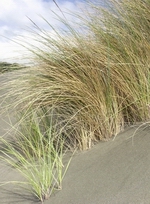 The exotic grass marram (Ammophila arenaria) was once widely used for dune stabilisation, but it's not as effective as native sand-binders in developing relatively stable foredunes. Marram grows in clumps and tends to build higher, steeper dunes that are more vulnerable to erosion and blow-outs.
The exotic grass marram (Ammophila arenaria) was once widely used for dune stabilisation, but it's not as effective as native sand-binders in developing relatively stable foredunes. Marram grows in clumps and tends to build higher, steeper dunes that are more vulnerable to erosion and blow-outs.
Marram does look similar to spinifex so they're easily confused – some ways to tell them apart are:
· Marram has darker green, shinier leaves than spinifex.
· Marram grows in clumps with a deep root and rhizome system, while spinifex has runners that spread evenly across the top of the dune.
Pingao
Golden sand sedge | Ficinia spiralis
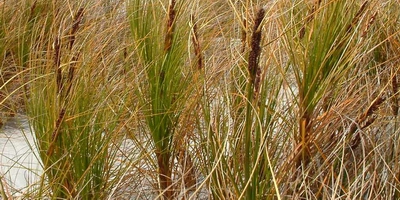
Pingao is widely used for dune restoration projects. As well as its sand-binding properties, pingao is much prized as a material for weaving. It grows only in New Zealand and is in decline.
Description:
This tussock-like perennial plant grows 30-90cm tall and is found on active sand dunes. Its narrow leaves are bright green, becoming orange or yellow as they age.
Flowers and seeding:
Dark brown flower heads appear in spring, with small flowers arranged in a spiral pattern. Small black seeds appear from early summer. In Northland the seed usually ripens in December.
Threats:
Rabbits and stock eat pingao. Damage from vehicles and careless harvesting of leaves also reduce populations.
Establishment:
Pingao can be grown from seed. The plants grow best in the mobile sand at the front of the dune, though it can also grow further landward.
Sand Tussock
Hinarepe | Poa bilardierei
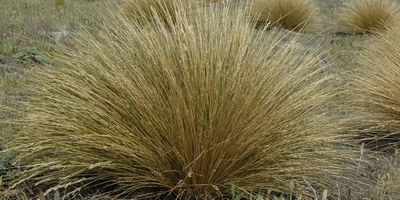
Sand tussock grows on semi-stable sand dunes. Once common, there are now only a few remnant populations of this native in Northland.
Description:
Sand tussock grows 50-90cm tall. Its smooth, yellow-green leaves are stiff and sharply pointed. They have distinctive, narrow, wheat-like seedheads.
Flowers and seeding:
Flowers appear in early summer, and seeds appear mid to late summer.
Threats:
It's damaged by stock grazing, browsing by rabbits, coastal development and vehicles.
Establishment:
Nursery-raised plants from locally collected seed can be successfully established on semi-stable, lightly vegetated sand flats and low foredunes.
Sand sedge
Carex pumila
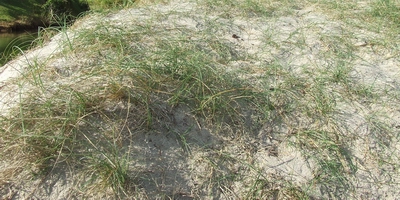
This native sedge is a sand-binder which is often found growing in damp dune hollows, on the foredune and on the edges of streams and rivers where they meet the beach.
Description:
Sand sedge has short, pointed, blue-green curled leaves which are often partially buried in the sand.
Flowers and seeding:
Flowers appear from October to December, and fruits from December to June. The distinctive yellow-brown seed-heads are found near the base of the leaves.
Establishment:
Sand sedge can be easily grown from seed and planted along the toe of foredunes near stream mouths. It often regenerates naturally from seed spread by freshwater.
Shore Bindweed
Nihinihi | Sand convolvulus | Calystegia soldanella
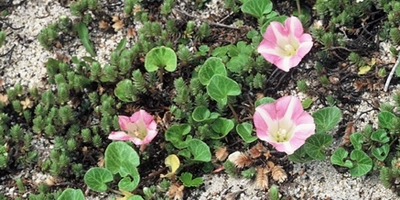
The native shore bindweed is found growing on the foredune amongst spinifex and pingao, and also in the mid-dune area. It is sometimes mistaken for an exotic weed.
Description:
This perennial herb with round leaves has stout fleshy roots and branching stems that form dense patches.
Flowers and seeding:
Solitary pink and white flowers appear from October to March. It produces smooth, dark brown seeds.
Establishment:
Shore bindweed regenerates naturally on most foredunes, often amongst a light cover of the native sand-binders.
